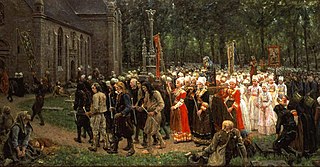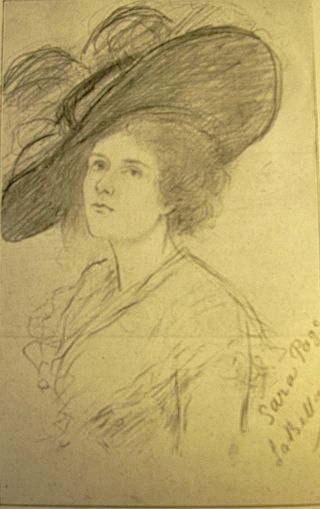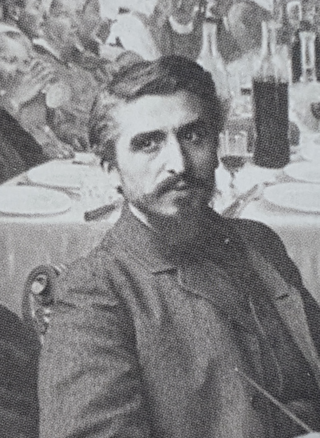
Eugène Henri Paul Gauguin was a French painter, sculptor, printmaker, ceramist, and writer, whose work has been primarily associated with the Post-Impressionist and Symbolist movements. He was also an influential practitioner of wood engraving and woodcuts as art forms. While only moderately successful during his lifetime, Gauguin has since been recognized for his experimental use of color and Synthetist style that were distinct from Impressionism.

The Nabis were a group of young French artists active in Paris from 1888 until 1900, who played a large part in the transition from Impressionism and academic art to abstract art, symbolism and the other early movements of modernism. The members included Pierre Bonnard, Maurice Denis, Paul Ranson, Édouard Vuillard, Ker-Xavier Roussel, Félix Vallotton, Paul Sérusier and Auguste Cazalis. Most were students at the Académie Julian in Paris in the late 1880s. The artists shared a common admiration for Paul Gauguin and Paul Cézanne and a determination to renew the art of painting, but varied greatly in their individual styles. They believed that a work of art was not a depiction of nature, but a synthesis of metaphors and symbols created by the artist. In 1900, the artists held their final exhibition and went their separate ways.

Le Déjeuner sur l'herbe – originally titled Le Bain – is a large oil on canvas painting by Édouard Manet created in 1862 and 1863.

Jules Adolphe Aimé Louis Breton was a 19th-century French naturalist painter. His paintings are heavily influenced by the French countryside and his absorption of traditional methods of painting helped make him one of the primary transmitters of the beauty and idyllic vision of rural existence.
The year 1887 in art involved some significant events.

Pont-Aven School encompasses works of art influenced by the Breton town of Pont-Aven and its surroundings. Originally the term applied to works created in the artists' colony at Pont-Aven, which started to emerge in the 1850s and lasted until the beginning of the 20th century. Many of the artists were inspired by the works of Paul Gauguin, who spent extended periods in the area in the late 1880s and early 1890s. Their work is frequently characterised by the bold use of pure colour and their Symbolist choice of subject matter.
Paul Gauguin's exhibit at Les XX in 1889 was the first important display of Paul Gauguin's works, and added to the recognition that he had begun to receive in 1888. The annual exhibition was organized by Les XX, and participation was by invitation only. Gauguin's exhibit comprised paintings from Martinique, Brittany and Arles. Many of these can be identified easily, but for several items the discussion is not yet closed.

A pardon is a typically Breton form of pilgrimage and one of the most traditional demonstrations of popular Catholicism in Brittany. Of very ancient origin, probably dating back to the conversion of the country by the Celtic monks, it is comparable to the pattern days of pre-famine Ireland.

Pascal-Adolphe-Jean Dagnan-Bouveret was a French painter, one of the leading members of the naturalist school.

Sara Wells Page (1855–1943) was a British artist, portrait and figurative painter, of the Victorian and Edwardian period. During her lifetime she was widely exhibited at Parisian salons and British galleries, including the Royal Academy of Arts. Three of her paintings are in Wolverhampton Art Gallery.

Breton costume is the style of clothing worn by the Bretons as formal wear or festive clothing.

Alfred Guillou was a French painter of Breton heritage.
Ferdinand du Puigaudeau (1864-1930) was a French painter. He was born in Nantes on 4 April 1864 and died in Croisic on 19 September 1930.

Henry d'Estienne was a French painter and a member of the Académie des Beaux-Arts.

Margaret Campbell Macpherson was an artist born in St. John's, Newfoundland and Labrador. Macpherson was well known for her various works of paintings in Scotland. Macpherson later died in Versailles, France.

Stansmore Richmond Leslie Dean Stevenson was a Scottish artist known for her oil paintings. She was a member of a group of women artists and designers known as the Glasgow Girls.
In Breton tradition, a coiffebigoudène is a women's coif worn with traditional Breton costumes. By extension, the women wearing the coif and the costume associated with it are also called bigoudènes. The coif is about 30 cm high, and up to 40 cm in Penmarc'h.

The Pension Gloanec was an inn in Pont-Aven, Brittany, France, that was a base for artists of the Pont-Aven School in the last half of the 19th century. It was known for economical but excellent quality food, where the diners served themselves from shared dishes set out on a long table in the dining room. There were few rooms, so most of the artists boarded elsewhere in the town. Its most famous resident was Paul Gauguin who stayed several times between 1886 and 1894. Today the building houses a bookstore, gallery and exhibition space.





















